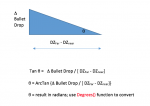Hello
Having discussions with shooting buddies on bullet arc, arc when past the target and ricohet. Hopefully my questions make sense.
When shooting past ELR yards, any thoughts on the actual bullet angle when it impacts the target?
For example, using ballistic AE, 300 Win Mag, 29.92, 59.9 degrees, 0% humidity, zero wind, 190gr Sierra MK BTHP, 2900 fps. The drop at 1200 yards is 509.2"
1. what would be the impact angle into the target? Does it arc into the target or is it straight in?
2. If one was shooting paper at that distance, when the bullet impacts, does it continue it's downward trajectory and impact a few feet pass the target?
3. At these distance, assuming the argument of the bullet is arcing down, on a miss, what is the probability of a ricohet?
Thank you in advance for your wisdom
Having discussions with shooting buddies on bullet arc, arc when past the target and ricohet. Hopefully my questions make sense.
When shooting past ELR yards, any thoughts on the actual bullet angle when it impacts the target?
For example, using ballistic AE, 300 Win Mag, 29.92, 59.9 degrees, 0% humidity, zero wind, 190gr Sierra MK BTHP, 2900 fps. The drop at 1200 yards is 509.2"
1. what would be the impact angle into the target? Does it arc into the target or is it straight in?
2. If one was shooting paper at that distance, when the bullet impacts, does it continue it's downward trajectory and impact a few feet pass the target?
3. At these distance, assuming the argument of the bullet is arcing down, on a miss, what is the probability of a ricohet?
Thank you in advance for your wisdom



